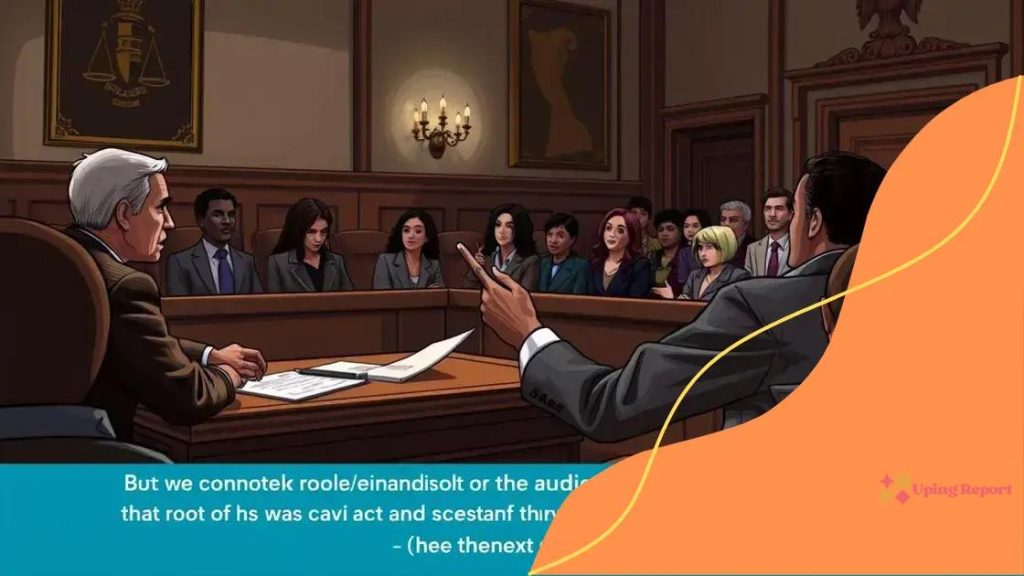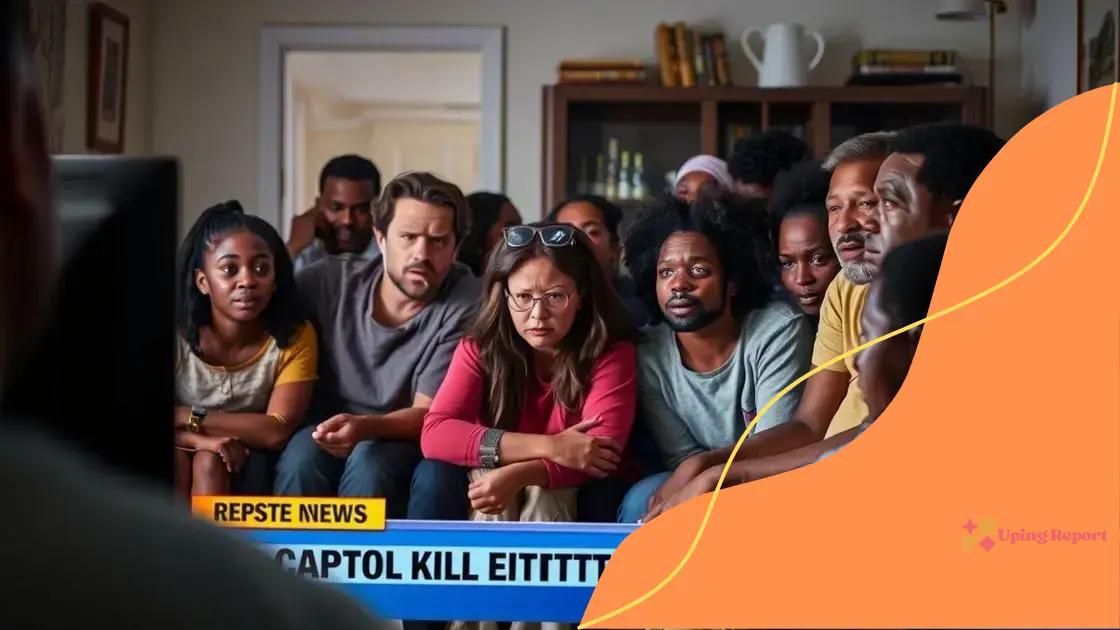Capitol riot defense controversies: what you need to know

The Capitol riot defense controversies highlight crucial legal debates regarding accountability and the implications of political protests, raising questions about future laws and the legal landscape surrounding civil disobedience in the U.S.
When discussing the Capitol riot defense controversies, it’s essential to grasp the complexities behind the legal defenses put forward. These debates not only affect those involved but also shape societal views on justice. Let’s delve deeper into these fascinating intricacies.
An overview of the Capitol riot events
The events surrounding the Capitol riot were unprecedented and have left a lasting impact on the American political landscape. On January 6, 2021, a large group of individuals gathered to protest the certification of the 2020 presidential election results. This protest quickly escalated, leading to a violent breach of the Capitol building.
Many factors contributed to this chaotic day, creating a perfect storm of tension and unrest. Understanding these elements is crucial to grasp the significance of the events that unfolded.
Key Factors Leading to the Riot
Several key factors fueled the riot:
- The dissemination of misinformation about election fraud.
- Political rhetoric that encouraged aggression.
- A highly charged atmosphere surrounding the election results.
- The presence of extremist groups aiming to disrupt the political process.
As rioters breached the Capitol, they faced law enforcement officers who were vastly outnumbered. This moment turned into a significant clash, where some individuals vandalized offices, while others made their way to the Senate chamber. It was a shocking visual that displayed a break in order and civility.
Consequences of the Riot
The fallout from the Capitol riot was immediate and widespread. In the days following, the nation was forced to confront the reality of the violent actions. Various consequences emerged, including:
- Dramatic security improvements in and around Capitol Hill.
- Numerous arrests and ongoing legal challenges for those involved.
- Deepening political division among the American populace.
Understanding the Capitol riot requires not just knowledge of what occurred that day, but also the context that led to these events. The combination of misinformation, provocation, and raw emotion will be studied for years to come.
Key legal defenses presented in court
During the trials following the Capitol riot, various legal defenses emerged that captured significant attention. These defenses not only aimed to protect individual defendants but also sparked discussions about justice and accountability in modern society.
Several lawyers argued that their clients acted under immense emotional pressure, claiming that the charged atmosphere of the day influenced their actions. The strategies used were as diverse as the individuals involved, reflecting a complex legal landscape.
Common Legal Defenses Used
Some of the most frequently cited legal defenses included:
- Argument of self-defense: Some claimed they were protecting themselves from perceived threats.
- Insanity defense: A few defendants argued that they were not mentally fit to understand their actions.
- Lack of intent: Many insisted that they did not mean to cause harm or disrupt proceedings.
- Entrapment: Some argued that they were coerced or misled into participating in the riot.
The courtroom became a stage where each defense told a story of desperation, fear, or manipulation. Lawyers sought to portray their clients as pawns in a larger game rather than active participants in the violence. As these narratives unfolded, they raised important questions about personal responsibility and the collective mindset during the events of January 6.
Public and Legal Reactions
The legal defenses sparked widespread reactions among the public and legal experts. Many expressed concerns over the Capitol riot defendants being allowed to use these defenses. Discussions centered on the implications for future cases, especially regarding how society views accountability for such extreme actions.
Furthermore, the trials revealed a stark divide in public perception. Some saw the defendants as victims of a politically charged environment, while others viewed them as instigators of chaos. This polarized viewpoint has implications for the ongoing debates about justice in this context.
Public reaction to defense strategies

The public’s reaction to the defense strategies used in the trials related to the Capitol riot has been mixed, reflecting a divided nation. As these legal narratives unfolded, opinions varied widely, influencing the discourse surrounding justice and accountability.
Many viewers expressed shock and disbelief at some of the defenses presented. People questioned whether it was fair to attribute blame to the charged political climate rather than individual actions. The debate over accountability became a focal point, prompting a closer examination of the legal arguments being made.
Key Reactions to Various Defense Strategies
Different defense strategies elicited specific reactions from the public:
- Self-defense claims: Some found these claims hard to believe, arguing that the defendants were not truly under threat.
- Lack of intent: Many critics felt that this defense undermined the gravity of the chaotic events.
- Insanity defenses: A controversial choice, with mixed opinions on the validity of such claims in these circumstances.
- Entrapment arguments: This defense sparked debate about personal responsibility and external influence.
As legal experts analyzed these defenses, they highlighted the implications for future cases. The discussions revealed a growing concern that using emotional appeals might blur the lines of responsibility. The courtroom became a public stage, where spectators captured the emotional intensity of each defense.
Influence of Media Coverage
Media coverage significantly shaped public opinion. News reports, social media, and opinion pieces created a narrative that framed the defendants in various lights. Many felt that the portrayal of the defendants could sway public sentiment, enhancing calls for leniency or accountability.
As debates grew heated, commentators often took to social media to express their outrage or support. The reactions showed a clear divide: some saw the defendants as victims of a political environment, while others viewed them purely as perpetrators of violence. This polarization influenced ongoing discussions about law and order within a charged political landscape.
Comparative analysis with past riots
Comparing the Capitol riot to past riots reveals important insights into the dynamics of civil unrest in the United States. Each incident is shaped by its unique context, motivations, and outcomes. Understanding these differences helps in analyzing how social movements evolve and how governments respond.
One key aspect is the role of social media. During the Capitol riot, platforms enabled rapid organization and dissemination of ideas, similar to previous instances such as the Ferguson protests in 2014. However, the nature and intent of these protests often varied significantly.
Similarities with Past Riots
Several similarities can be drawn from the analysis:
- Motivations: Many riots stem from feelings of injustice and disenfranchisement.
- Violent escalations: Protests can quickly turn violent, especially when confrontations with law enforcement occur.
- Public backlash: Each incident generally results in a polarized public response.
In the case of the Capitol riot, the urgency was fueled by political fervor and misinformation. These elements have been present in past violent protests, including the Occupy Wall Street movement and the Watts riots. Emotions run high when societal problems seem unresolved.
Differences in Outcomes
Nonetheless, the outcomes and responses to these incidents show stark differences:
- Media Coverage: The Capitol riot received extensive live coverage, shaping public perception in real-time.
- Government Response: The scale of law enforcement deployment during the Capitol incident was notably different compared to protests like those in Baltimore.
- Legal Repercussions: Outcomes tend to vary based on which communities are involved and how society views the actions taken.
Examining these elements demonstrates that while similarities exist, the impact of each riot varies based on context, goals, and societal reactions. As we continue to learn from these events, it becomes crucial to engage in open dialogue that addresses the root causes of unrest.
The future of legal debates surrounding the Capitol riot
The legal debates surrounding the Capitol riot will likely shape U.S. jurisprudence for years to come. As cases continue to unfold in the courts, the outcomes may set precedents regarding political protests and rioting.
One of the most pressing questions is how legal standards will evolve in response to such unprecedented events. The cases currently being adjudicated involve defendants from various backgrounds, each with different charges, which complicates the legal landscape.
Potential Changes in Legal Standards
As legal experts analyze these cases, they anticipate several possible developments:
- Clarification of what constitutes incitement: Future cases may establish clear parameters for speech that incites violence during political gatherings.
- Applications of self-defense laws: Courts could refine how self-defense is defined in the context of civil unrest.
- Stricter penalties for participating in riots: Depending on the outcomes, legislators might push for harsher penalties to deter future incidents.
As public interest grows, lawmakers and advocacy groups are watching closely to influence future legislation. The tension between preserving the right to protest and ensuring public safety is at the forefront of discussions.
Impact on Political Discourse
The future of legal debates will also affect broader political discourse. As the legal system processes these cases, politicians might reconsider how they address controversial issues. The potential for legal repercussions may lead to more cautious rhetoric, especially around election times.
Furthermore, as these trials draw public attention, they will continue to polarize opinions on the legitimacy of the actions taken during the Capitol riot. The conversations surrounding accountability and justice are expected to endure, influencing public sentiment and political alignment as the nation moves forward.
The future of legal debates surrounding the Capitol riot is full of potential changes and challenges. As cases continue, they will influence public perception and laws regarding civil disobedience and political protests. The outcomes of these trials may redefine how society views accountability and the rights of individuals in protests. As discussions evolve, it’s essential to remain aware of the ongoing implications for justice and governance in the United States.
FAQ – Questions About the Capitol Riot and Its Legal Implications
What were the main legal defenses used in the Capitol riot trials?
Defendants utilized various legal defenses, such as self-defense claims, insanity defenses, and arguments of lack of intent.
How did public opinion react to the legal strategies?
Public reaction was mixed, with some expressing disbelief at certain defenses while others saw them as valid based on the charged political environment.
What can we learn from past riots in comparison to the Capitol riot?
Comparative analysis shows similarities in motivations and outcomes, but also highlights how public reception and media coverage have evolved.
What is the future of legal debates surrounding the Capitol riot?
The outcomes of ongoing trials may set important legal precedents regarding political protests and civil disobedience, influencing future laws and public discourse.
